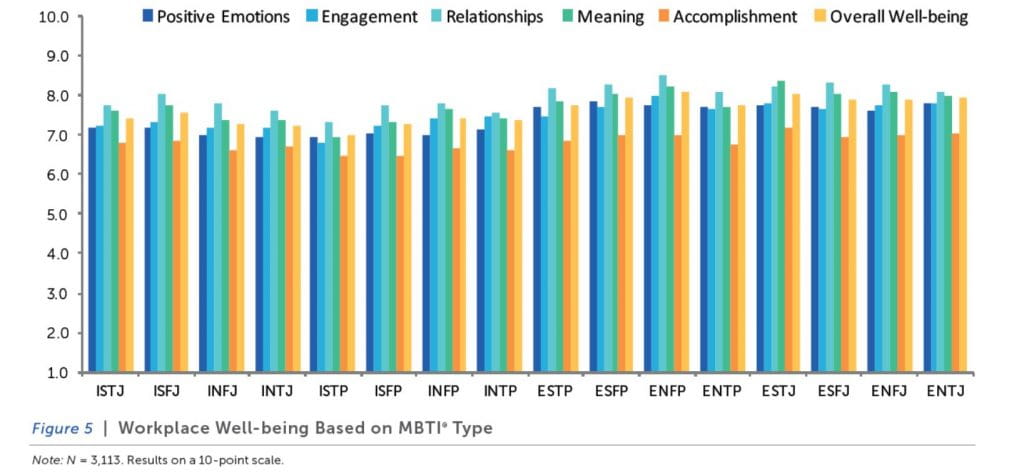How to be happier using self-awareness and Myers-Briggs personality type
Melissa, MBTI Marketing Manager

One way to increase your happiness (or “well-being” as scientists like to call it) is to increase your self-awareness. By becoming more self-aware, you can tailor strategies to be happier specifically to you. Because let’s be honest, you are not the same as everyone else so different things will make you happy than other people.
First, if you haven’t heard of the PERMA model, take a look at this blog for an explanation.
We’ve recently done some research on Myers-Briggs Type and workplace happiness that you can definitely benefit from. Take a look at the information below and ask yourself, “does this ring true for me?”
Our survey was sent out to 3,000 people with verified Myers-Briggs type and we asked them about what makes them happy at work as far as the PERMA model, age, job, where they live, and activities that they do to increase happiness.
While we uncovered a lot of data, we’re going to focus on Myers-Briggs type and the PERMA model.
Differences in Happiness by Myers-Briggs Personality Type
- People with a preference for Introversion show lower levels of workplace well-being than those with a preference for Extraversion:
- Those with preferences for ISTP (Introversion, Sensing, Thinking, Perceiving) show the lowest levels of overall well-being
- People with a preference for ENFP (Extraversion, Intuition, Feeling, Perceiving) show the overall highest well-being
- ENFP respondents had especially high Engagement and Relationship PERMA scores

So who rated each of the PERMA factors as being most important to their happiness?
Positive Emotions:
Those with ESFP, ENTJ and ESTJ personality types rated positive emotions as highly contributing to their well-being.
INFP, ISTP and INTJ types rated this as contributing the least to their happiness compared to the other MBTI personality types.
Engagement:
Those with ENFP, ESTJ and ENTJ personality types rated engagement as highly contributing to their well-being.
INFJ, INTJ and ISTP types rated this as contributing the least to their happiness compared to the other MBTI personality types.
Relationships:
People with ENFP, ESFJ and ESFP personality types rated relationships as highly contributing to their well-being.
Those with INTJ, INTP and ISTP types rated this as contributing the least to their happiness compared to the other MBTI personality types.
Meaning:
People with ESTJ, ENFP and ENFJ personality types rated meaning as highly contributing to their well-being.
People with INTJ, ISFP and ISTP personality types rated this as contributing the least to their happiness compared to the other MBTI personality types.
Accomplishment:
Those with ESTJ, ENTJ and ENFJ personality types rated accomplishment as highly contributing to their well-being.
INTP, ISTP and ISFP MBTI types rated this as contributing the least to their happiness compared to the other MBTI personality types.
Try This to Improve Your Happiness
Your turn.
- On a scale of 1-10, rank each of the PERMA factors in how highly they contribute to your happiness.
- Of the PERMA factors, what are the two that rank highest for you?
- What are the two that rate lowest?
- Check how your Myers-Briggs type compares to our sample above.
As we’ve mentioned before, MBTI measures just a few parts of your personality, and no two people with the same MBTI type will be exactly the same because of environment, upbringing, brain chemistry, and other personality factors the MBTI tool doesn’t measure.
5. Now look at how you spend your time at work and your free time (use last week and last weekend as an example).
6. What are two changes you could make in how you spend your time that could better contribute to your two highest PERMA factors? If Meaning ranks highly for you, but you spent most of your weekend taking time for your relationships, maybe it’s time to do something like volunteering for a non-profit or doing something that specifically hits on what brings you meaning.
7. For the next three days, keep your top two PERMA factors in mind and try to dedicate more time to these.
The self-awareness of knowing your Myers-Briggs type as well as what makes you as an individual happiest can go a long way to making your life the best it can be.
